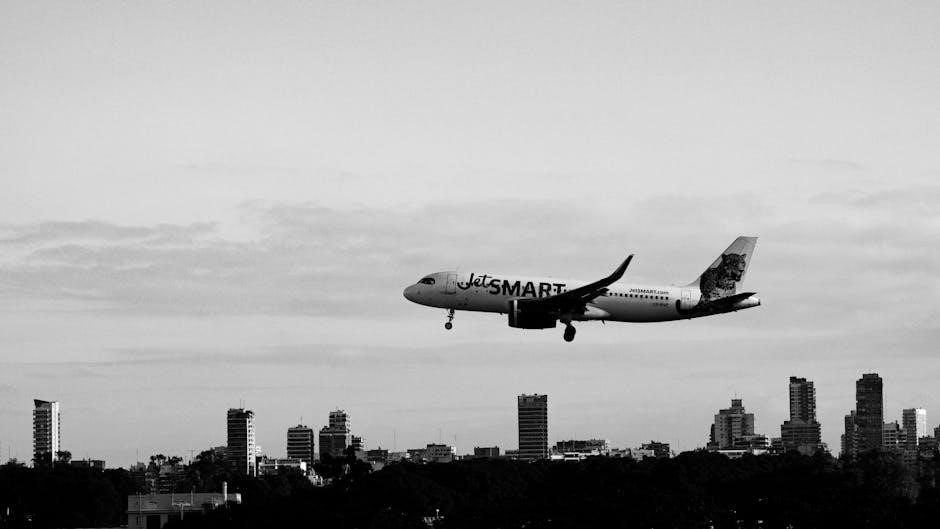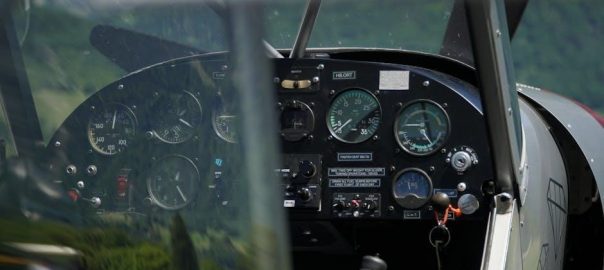The Aviation Guide provides comprehensive insights into the world of flight, covering its history, modern advancements, and future trends. This guide explores key components of aviation, including aircraft design, propulsion systems, and navigation technologies. It also delves into the aviation industry’s economic impact, passenger experiences, and the critical roles of pilots and air traffic controllers. Safety measures and upcoming innovations are highlighted, offering a well-rounded understanding of aviation’s complexities and opportunities.
History of Aviation
The history of aviation is a fascinating journey marked by groundbreaking innovations and pioneering spirits; It began centuries ago with humanity’s earliest attempts to fly, inspired by observations of birds and gliding insects. The concept of flight evolved significantly over time, with inventors like Leonardo da Vinci sketching designs for flying machines in the 15th century. However, it wasn’t until the late 19th and early 20th centuries that aviation started to take shape as a practical reality.
The Wright Brothers, Orville and Wilbur Wright, are celebrated for achieving the first powered, controlled, and sustained flight on December 17, 1903. Their Wright Flyer, which took to the skies at Kitty Hawk, North Carolina, marked a monumental milestone in aviation history. This achievement sparked global interest and spurred rapid advancements in aircraft design, materials, and propulsion systems.
During World War I, aviation transitioned from a novelty to a critical military tool, with planes being used for reconnaissance, combat, and surveillance. The interwar period saw the rise of commercial aviation, with airlines like Boeing Air Transport and Pan American Airways emerging to connect cities and countries. The 1930s are often referred to as the “Golden Age of Aviation,” characterized by iconic aircraft like the DC-3, which revolutionized passenger travel.
World War II further accelerated aviation technology, leading to the development of jet engines and radar systems. The post-war era witnessed the dawn of the jet age, with commercial jets like the de Havilland Comet and Boeing 707 transforming air travel into a faster, more accessible mode of transportation. Today, aviation is a cornerstone of global connectivity, with millions of people and tons of cargo moving through the skies daily.

The evolution of aviation is a testament to human ingenuity and the relentless pursuit of progress. From humble beginnings to the sophisticated aircraft of today, the history of aviation is a story of vision, innovation, and collaboration that continues to shape the modern world.
Key Components of Modern Aviation
Modern aviation is a complex and highly sophisticated industry, relying on several critical components to ensure safe, efficient, and reliable operations. At the heart of aviation lies the aircraft itself, which is designed with cutting-edge technology to withstand the stresses of flight and provide comfort for passengers. These aircraft are equipped with advanced avionics systems, including navigation, communication, and flight control technologies, which enable precise and autonomous operations.
Propulsion systems are another vital component, with most modern aircraft powered by high-efficiency jet engines or turboprop engines. These engines are designed to minimize fuel consumption while maximizing performance, making air travel both cost-effective and environmentally friendly. Additionally, the development of electric and hybrid-electric propulsion systems is gaining momentum, promising even greater efficiency and reduced emissions in the future.
Air traffic control (ATC) is a cornerstone of modern aviation, ensuring the safe and orderly movement of aircraft through airspace. ATC systems rely on radar, GPS, and advanced software to track flights, manage traffic flow, and prevent collisions. Communication between pilots and controllers is facilitated through standardized protocols and technologies like voice and data link systems.
Pilot training and licensing are essential to maintaining high standards of safety and professionalism within the industry. Pilots undergo rigorous training programs to master aircraft operations, navigate complex weather conditions, and respond to emergencies. Licensing requirements ensure that only qualified individuals are permitted to fly commercial or private aircraft.
Maintenance and ground operations are equally critical, ensuring that aircraft are airworthy and ready for flight. This includes regular inspections, repairs, and upgrades performed by skilled technicians. Ground handling services, such as fueling, baggage handling, and catering, also play a key role in the smooth operation of flights.
Finally, sustainability is an increasingly important component of modern aviation. Efforts to reduce carbon emissions, noise pollution, and environmental impact are driving innovation in aircraft design, fuel efficiency, and operational practices. These advancements aim to make aviation more eco-friendly while maintaining its role as a vital global transportation network.

The Aviation Industry
The aviation industry is a global powerhouse, playing a critical role in connecting people, goods, and services worldwide. It encompasses a wide range of sectors, including commercial airlines, general aviation, military aviation, and aircraft manufacturing. The industry is characterized by its dynamic nature, driven by technological advancements, economic demands, and regulatory frameworks.
Commercial airlines form the backbone of the industry, providing passenger and cargo transport services. These airlines operate on a massive scale, with thousands of flights taking place daily across the globe. The rise of low-cost carriers has made air travel more accessible, while legacy airlines continue to offer premium services, catering to diverse customer needs.
The aviation industry is also a significant economic driver, generating millions of jobs directly and indirectly. From pilots and maintenance engineers to ground staff and airport personnel, the industry employs a vast workforce. Additionally, it contributes to the growth of tourism, trade, and global connectivity, making it indispensable to modern economies.
Infrastructure development is another key aspect of the aviation industry. Airports, considered the lifeline of aviation, are continuously expanded and modernized to accommodate growing passenger numbers and larger aircraft. The development of air traffic control systems, navigation aids, and ground handling services further supports the industry’s operations.
However, the industry faces challenges such as rising fuel costs, environmental concerns, and stringent safety regulations. Airlines and manufacturers are investing in sustainable practices, such as electric aircraft and biofuels, to reduce their carbon footprint. Additionally, advancements in technology, including AI-driven systems and predictive maintenance, are transforming the industry’s efficiency and safety standards.
Passenger Experience
The passenger experience is a critical aspect of aviation, shaping traveler satisfaction and loyalty. From check-in to arrival, airlines strive to provide seamless, comfortable, and enjoyable journeys. Modern advancements have transformed the passenger experience, with digital solutions like online check-in, mobile boarding passes, and self-service kiosks streamlining processes. These innovations reduce wait times and enhance convenience for travelers.
In-flight comfort and amenities play a significant role in passenger satisfaction. Airlines offer a range of seating options, from economy to premium classes, each tailored to different needs and budgets. Premium cabins often feature lie-flat beds, gourmet meals, and personalized entertainment systems. Economy class has also seen improvements, with advances in seat design and in-flight entertainment.
Customer service is another key factor in the passenger experience. Airline staff, from check-in agents to cabin crew, are trained to ensure travelers feel safe and supported. Effective communication, especially during delays or disruptions, is crucial for maintaining trust and satisfaction. Many airlines now use feedback systems to address passenger concerns and improve services.
Technological advancements continue to enhance the passenger experience. Wi-Fi connectivity, real-time flight updates, and personalized entertainment are becoming standard. Some airlines are even exploring virtual reality (VR) and augmented reality (AR) to create immersive in-flight experiences. These innovations aim to make flying more enjoyable and engaging for all passengers.
Ultimately, the passenger experience is central to the aviation industry’s success. By focusing on comfort, convenience, and customer care, airlines aim to create memorable journeys that keep travelers coming back. As technology evolves, the passenger experience will continue to improve, setting new standards for the future of air travel.
Pilot Training and Licensing
Pilot training and licensing are fundamental to ensuring the safety and efficiency of air travel. Becoming a licensed pilot requires a rigorous process that combines theoretical knowledge, practical skills, and continuous evaluation. The journey typically begins with ground school, where aspiring pilots study subjects such as weather patterns, navigation, aircraft mechanics, and aviation regulations. This foundational knowledge is essential for understanding the complexities of flight operations.
Flight training is the next critical step, where students apply their knowledge in real-world scenarios. Under the supervision of certified instructors, trainees learn to operate aircraft safely, perform takeoffs and landings, and navigate through various weather conditions. The training progresses from small, single-engine planes to more complex aircraft, depending on the type of license being pursued, such as a Private Pilot License (PPL) or Airline Transport Pilot License (ATP).
Licensing requirements vary by country and the type of aircraft being flown. In most jurisdictions, pilots must pass a series of exams, including written tests and practical flight assessments. Additionally, they must undergo regular medical evaluations to ensure they are fit to fly. Commercial pilots, for example, require a Class 1 medical certificate, while recreational pilots may need a less stringent evaluation.
Recurrent training is another crucial aspect of a pilot’s career. Airlines and aviation authorities mandate periodic refresher courses to keep pilots updated on the latest technologies, safety protocols, and regulatory changes. This ongoing education ensures that pilots remain proficient and adaptable in an ever-evolving industry.
Air Traffic Control

Air Traffic Control (ATC) is a critical component of modern aviation, responsible for ensuring the safe and efficient movement of aircraft. ATC manages the flow of air traffic, coordinating takeoffs, landings, and en-route operations to prevent collisions and minimize delays. Controllers use advanced radar systems, communication technologies, and real-time data to monitor and guide aircraft through all phases of flight.
There are several types of ATC, each serving a specific function. Tower controllers oversee operations at airports, managing ground movements, takeoffs, and landings. Approach controllers guide aircraft approaching airports, ensuring safe descents and proper sequencing. En-route controllers handle aircraft during cruising altitudes, monitoring their progress along flight routes and adjusting paths as needed.
Effective communication is paramount in ATC. Controllers use standardized terminology and protocols to issue clear instructions to pilots. Additionally, they rely on tools like flight data processors and surveillance systems to track aircraft positions and predict potential conflicts. Weather plays a significant role in ATC operations, as controllers must adapt to changing conditions that could impact flight paths or airport capacity.
Training to become an air traffic controller is highly specialized and demanding. Candidates undergo extensive education and simulation-based training to develop the skills needed for this high-stress profession. Controllers must remain vigilant, make quick decisions, and maintain situational awareness at all times. The role of ATC continues to evolve with advancements in technology, such as automated systems and artificial intelligence, which aim to enhance safety and efficiency in managing global air traffic.

Aviation Safety
Aviation safety is a cornerstone of the aviation industry, ensuring the well-being of passengers, crew, and aircraft. It encompasses a wide range of practices, regulations, and technologies designed to minimize risks and prevent accidents. Safety protocols are implemented at every stage of flight operations, from aircraft design and maintenance to pilot training and air traffic management.
Regulatory bodies, such as the International Civil Aviation Organization (ICAO) and national aviation authorities, establish strict safety standards that airlines and airports must adhere to. These standards cover aircraft certification, crew training, and operational procedures. Regular inspections and audits are conducted to ensure compliance and identify potential hazards before they escalate.
Modern aviation relies heavily on advanced technologies to enhance safety. Systems like collision avoidance systems, weather radar, and automated flight control reduce human error and improve decision-making. Additionally, airlines implement robust maintenance programs to ensure aircraft airworthiness, while pilots undergo rigorous training to handle emergencies effectively.
Incident reporting and investigation are critical components of aviation safety. When accidents or near-misses occur, investigators analyze the causes to identify systemic issues and recommend preventive measures. This continuous improvement process has significantly reduced accident rates over the years, making air travel one of the safest modes of transportation.
Passenger safety briefings, emergency procedures, and cabin crew training are also essential elements of aviation safety. Airlines educate passengers on the use of safety equipment and emergency exits, ensuring everyone on board is prepared for unexpected situations. The collective effort of all stakeholders ensures that aviation remains a safe and reliable way to travel.
Future of Aviation
The future of aviation is poised for transformative change, driven by technological advancements, environmental concerns, and evolving passenger demands. Electric and hybrid-electric propulsion systems are emerging as game-changers, promising to reduce carbon emissions and operating costs. These innovations could revolutionize regional air travel, making it more sustainable and accessible. Additionally, urban air mobility (UAM) is gaining traction, with electric vertical takeoff and landing (eVTOL) aircraft set to transform city transportation, offering on-demand flights within urban areas.
Sustainability is at the forefront of aviation’s future. The industry is exploring alternative fuels, such as sustainable aviation fuel (SAF), which can significantly reduce greenhouse gas emissions. Airlines and manufacturers are also investing in greener technologies, including more efficient engines and lightweight materials. Furthermore, airports are adopting renewable energy sources and implementing eco-friendly infrastructure to minimize their environmental footprint.
Artificial intelligence (AI) and automation are reshaping aviation operations. AI-powered systems are being integrated into aircraft design, predictive maintenance, and air traffic control, enhancing safety and efficiency. Autonomous technologies, such as unmanned aerial vehicles (UAVs) and self-flying taxis, are also being tested, paving the way for a future where human pilots may no longer be required for certain operations.
The passenger experience is expected to become more personalized and seamless. Biometric technologies, such as facial recognition, will streamline check-in and boarding processes. In-flight entertainment and connectivity will be enhanced by high-speed internet and virtual reality (VR) capabilities, offering passengers immersive experiences during their journeys.
Collaboration between governments, industries, and innovators will be crucial to realizing these visions. Regulatory frameworks must evolve to accommodate new technologies while ensuring safety standards remain paramount. As aviation continues to adapt to global challenges, the future promises to be exciting, sustainable, and full of possibilities for travelers and industries alike.
